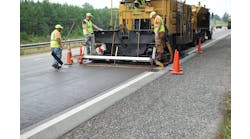By: Hossein Roshani, PhD., P.E. and Mohammadreza Gholikhani, PhD.
Sustainable development and roadway infrastructure are essential elements of future life quality. Powering and monitoring this infrastructure in a sustainable fashion are challenging problems that have been the subject of a considerable amount recent research. Roadway pavements are continuously exposed to various types of energy, such as traffic-induced strains and stresses generated by vehicles, solar radiation and heat.
Harnessing these forms of energy and converting them to a usable format can be potentially used for energy harvesting purposes. Energy harvesting, or energy scavenging, is a process that captures unused ambient energy that would otherwise be lost as heat, light, sound, vibration, stress, or movement. Energy harvesting from roadways has the potential to generate electricity for a roadside data collection, communication applications, and safety equipment. Roadside energy harvesters are broadly grouped into three categories based on the energy source tapped: mechanical energy from vehicles, pavement heat, and solar radiation. In terms of harvesting technology, harvesters are grouped into electromagnetic, piezoelectric, thermoelectric, pyroelectric, photovoltaic, and solar heat collectors involving liquid or air circulation.
Available Energy Harvesting Technologies/Methodologies
Electromagnetic energy harvesting technology captures the mechanical energy of vehicles on the roadways and generates electricity based on Faraday’s law. In practice, mechanical energy from a moving vehicle applies a force/displacement to a mechanical system that leads to relative movements between a magnet and coil, thereby generating electrical power. These mechanical systems can be divided into different mechanisms such as rack and pinion, cam and arm, hydraulic, linear generator, and chain-and-sprocket.
Piezoelectric materials have shown potential in harvesting mechanical energy from roadway pavements due to their simplicity and high-power density. Piezoelectric effect is generating electric energy in response to an applied stress/strain, and vice versa. The electrical energy stored in piezoelectric materials is released by connecting their poles to an external resistance. Piezoelectric materials are available in nature as a single crystal, such as quartz. There are also several synthetic piezoelectric materials, including the two most common: lead zirconate titanate (PZT) and polyvinylidene fluoride (PVDF). The piezoelectric elements are encased in a properly designed enclosure and installed in the pavement structure, near the surface, to capture stresses from passing vehicles.
Some piezoelectric materials have pyroelectric ability. Pyroelectricity is the ability of materials to convert thermal energy to electrical energy when heated or cooled. The pyroelectric current is directly proportional to the rate of change in temperature. Pyroelectric materials are a subset of piezoelectric materials; that is, some of the piezoelectric materials exhibit pyroelectric properties as well (e.g., PZT and PVDF). All the research that has focused on the pyroelectric effect has considered it part of a hybrid energy harvesting technology that combines pyroelectric and piezoelectric effects.
Another method of harvesting roadway energy is by collecting and conveying heat through a network of fluid pipes embedded into the pavement structure. Generally, this technology is based on exchanging the heat between the pavement and fluid in pipes embedded into the pavement, and storing the harvested heat in a suitable heat sink. These systems are often referred to as asphalt solar collectors (ASCs). Applications of this technology include melting pavement surface ice in the winter and reducing pavement surface temperature from hot pavement in the summer. Another application of these systems is utilizing the warm fluid to heat buildings.
A variation on systems that use a liquid fluid as the heat exchange medium are systems that utilize air. Heat harvesters using air as the exchange medium consist of pipes capable of circulating air embedded into the pavement surface. The air either absorbs or emits heat from/to the pavement surface depending on the temperature differential. Air circulation may be possible through convection, so there is no need for a circulating pump. Such systems may be able to use the air flow to activate a wind turbine and produce electricity.
Solar panels are used in a wide range of applications, from aerospace to transportation. Where installation space is not an issue, PV panels can be cost-effective in generating electrical power. However, when pavement surface is the only installation space available, adapting PV panels to become driving surfaces poses a unique set of challenges and will require considerable additional research and development. A PV cell surface must be supported by a structural frame capable of withstanding vehicular traffic and have sufficient friction to enable vehicular braking.
Comparison of Technologies
This section provides a summary comparison of the energy harvesting technologies. It consists of two parts; the first part summarizes the advantages and disadvantages of each type of harvesting energy technology (Table 1). The second part summarizes peak-power and power-density output for the most efficient system for each energy harvesting technology type (Table 1). For this purpose, efficiency is defined in terms of benefit-cost ratio. In addition, Table 2 summarizes levelized cost of energy (LCOE) of the electrical power being produced by each of these systems. LCOE is expressed as the ratio of the annualized harvester cost divided by the power generated annually. Another comparison tool is technology readiness level (TRL). The TRL ranges from 1 to 9, where 1 is the lowest level of readiness and 9 is the highest.
Closing
All of these energy harvesting technologies generate green renewable energy that can be used in roadside applications to power LED lights, sensors, and microprocessors for a multitude of data collection applications. Since the demand for smart highway features such as connectivity and signage are only going to increase, harvesting energy technology will soon become a necessity. The technologies that seem closest to implementation appear to be the thermoelectric and the piezoelectric harvesters. Although their power generation potential is lower than that of the better developed PV technology, they can be installed unobtrusively by simply embedding them into the pavement layers. The economic efficiency of these harvesting technologies needs to be re-evaluated as they become implemented on a wider scale to ensure that wider distribution will reduce their unit cost.
About The Author: Roshani is a project manager at Lockwood, Andrews & Newnam, Inc. Gholikhani is a transportation engineer at RJ Rivera and Associates, Inc.








